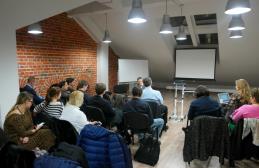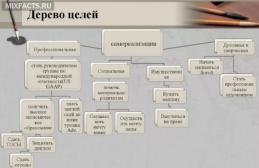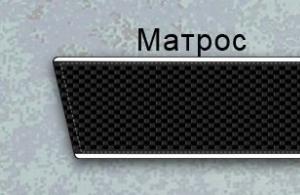Talk about the number of completed projects, the volume of products produced, publish successful cases. It is very important not to slip into self-praise, but to show how much real benefit your products or services brought.
Are your services useful? Tell us about it!
Post reviews from real customers with links to their social media profiles/company websites so that potential clients can get confirmation. 90% of people will not check the authenticity of these reviews, but such openness on your part will earn their trust.
High level of quality/service
And the standard continuation: “Our company employs highly qualified specialists who have undergone special training.”
At all The qualifications of specialists do not indicate the level of service, unless your employees took courses on “How to lick a client.”
Take the example of hotels for which international service standards have been developed. A person entering a three-star hotel already has a rough idea of what awaits him: a room with an area of at least 12 square meters. m, free bottled water, bathroom with towels, soap and toilet paper.
What can a client expect in your company?
Write to him how quickly the repair will be carried out or the goods will be delivered. Explain how the personal manager will work to solve his problem - step by step, from receiving the application to the result. Convince him that even after completing the order you are always ready to help.
Imagine calling a company about a large contract, and the sales representative replies, “We’re having lunch, call us later.” And hangs up. Will you call him back or find another supplier?
If the company's employees are not polite and friendly, your “high level of service” is worthless.
 What can your employees do?
What can your employees do? And if you want to boast about the professionalism of your employees, tell us about them separately: where they received their qualifications, how long they have been working in their specialty and what they can do.
Individual approach
This expression has not convinced potential customers for a long time, it is so hackneyed. Most often, they simply don’t notice him, and if they do, they grin skeptically, mentally saying “well, well, of course.”
Don't believe me? Look through the websites of your competitors - in 99 cases out of 100 you will find this phrase, if not on the “About the Company” page, then on some other page.
Replace general phrases with specific information.
List point by point everything you rely on when developing a project or completing an order. Explain what you mean by the concept of “individual approach”.
Surely put fulfilling the customer’s wishes first. But you understand that others are doing the same thing. Agree, it’s hard to imagine a designer who makes a red kitchen for clients who dream of a green one.
 Show HOW you fulfill customer desires
Show HOW you fulfill customer desires Write, what is included in your system of relationships with customers →
- How do you satisfy the needs of each client depending on the specifics of the tasks assigned to them. What exactly do you take into account when developing a project or completing an order?
- What additional terms of cooperation can you include in a standard contract at the client’s discretion: different payment schemes, individual discounts, delivery, assembly.
- How broad are the powers of the client who wishes to participate in the process or observe it with the possibility of adjustment. At what point are wishes no longer accepted?
Low prices and/or great deals
Another “nothing” stamp. And if you consider that not only low, but also high prices can drive sales with equal success, then this advantage becomes completely useless.
 Are you trying to attract customers with low prices? Do not do it this way!
Are you trying to attract customers with low prices? Do not do it this way! Instead of empty words use honest numbers.
For example: we offer Scandinavian-style kitchens at prices starting from 20,000 rubles per square meter; the basic package includes standard sections, a countertop, a sink, and a dish dryer.
Or: in January we are reducing the cost of the “Chicardos” collection by 30% - when ordering a kitchen 3 meters long, you save 25,000 rubles.
Most often, companies that have nothing else to attract a client say about low prices. Don't deny the buyer minimum math skills. Believe me, he will do a great job of comparing prices on his own.
When choosing a product, the buyer compares several alternative (not identical!) options:
- wooden houses - with brick and aerated concrete
- white gold jewelry - with silver and platinum
- facial mesotherapy - with sculptural massage and plasma lifting.
Make a comparison table, based on the results of which your offer wins as the safest, fastest to achieve, durable (warm, prestigious, comfortable - select the advantages of your product or service). And then the price will fade into the background.
A wide range of
These 18 characters without spaces will only become an advantage when the client sees them as a solution to their problems →
 Decipher what gives a wide range
Decipher what gives a wide range - Possibility of choosing from a specific product range. You can offer dozens or even hundreds of gold rings, but the buyer is interested in a specific size. And if it is not on the display of the online store, for the client the slogan about the richness of the assortment will remain zilch. An initially loyal visitor will go to competitors next time, so as not to be disappointed again.
- Opportunity to purchase related products- a lid for the frying pan, a brush for collecting animal hair - for the vacuum cleaner, wipes for cleaning the screen - for the monitor. This is beneficial for both parties. The client buys everything in one place and saves on delivery, the seller increases profits by 5-15%.
- Possibility to order a turnkey service. When you talk about a company's wide range of services, list them. Indicate which of them you provide separately and which ones only as a package. For example, a consulting company performs naming exclusively as part of a multi-stage company registration service, while assistance in preparing documents may be outside its scope.
Often a list of useless benefits is posted in the “About Us” section. Already fixed it? Great! Now check whether you have used all the ways to persuade customers on the “About” page. Look into the arguments that hit the mark.
And admit in the comments, do you often have professional professionals with an individual approach working in your companies? 😉
 About the author.
About the author.
You've spent a lot of time and effort creating a product and now you have to bring it to market. But before doing this, you need to understand what advantages this product or service has, which will make it stand out in the market, and what will make the buyer pay attention to it.
What kind of customer is he?
So, our task is to find the advantages of a product or service, its unique or especially useful properties. First, understand who you will be selling the product to. Who is it - a direct consumer or an intermediary company? The approaches in the first and second cases will differ.
If you offer a product/service to a consumer, then draw a rough portrait of your client. What does he like, what leaves him indifferent, what tasks does he face every day, what does he work on, what environment is he in? In other words, how will your product benefit him and what problems will it solve? Try to step into his shoes and answer all the questions as honestly as possible. Then it will become clear to you what characteristics your product should have in order to interest a potential buyer.
Would you sell this to your mother?
Take a close look at your product – what features does it already have? Write them down. Now pay attention to competing products. How does your product compare favorably with them? Maybe it has better and more convenient packaging, or maybe it is economical in consumption, easy to use, has a brighter taste, and is created using innovative technology. Record these moments too. Important factual information and figures that allow you to quickly assess the quality of the product should also be on this list.
Next, make a general list of benefits and imagine that you are recommending the product to your best friend, or mother, or child - it depends on who the target audience is. Which characteristics do you use first, which ones did you consider unimportant, and which ones were left for last, as a 100% argument? Based on this, highlight 3-5 key benefits of the product, 1-2 problems that it solves for the consumer. All that remains is to formulate them beautifully and convincingly in order to use them to promote the product on the market.
Let's say the product is a vegetable peeler. Target audience: women 30-50 years old with average/above average income. Each of them has a family and the need to cook a lot and often, but at the same time, they take care of their appearance. Based on the data, the most attractive properties will be the following: the vegetable peeler is convenient and safe to use, it helps to clean vegetables carefully and quickly, it is made of modern materials and will last a long time. It will help our customer prepare dinner twice as quickly, eliminate the tedious procedure and protect her manicure and hands in general from injury.
The concept of sustainable competitive advantage has been studied and discussed in detail by Michael Porter. Porter believed that a product has a competitive advantage when it has distinctive features that allow it to earn a higher rate of profit from the sale of a product or service than the market average. In this article we will analyze the term “competitive advantage of an enterprise”, consider the modern classification of competitive advantages and try to compile a comprehensive list of all sources of a company’s competitive advantage.
A few words from the author
Forming and achieving a sustainable competitive advantage of a product is a priority for any company. Competitive advantage provides stability, the possibility of long-term growth, creates barriers to entry for new players into the market, and allows the company to receive a higher rate of profit from the sale of its goods.
The concept of sustainable competitive advantage is often confused with the concept of “company strengths.” But these two concepts have a fundamental difference between themselves. - these are the characteristics of the product in which you are superior to your competitors. Competitors' products also have these characteristics, but at a weaker level. And a sustainable competitive advantage is a unique characteristic that only you have and no one else in the market has.
A unique competitive advantage can always be found for any object; it is only important to correctly analyze the market and competitors.
Requirements for creating a product advantage
For a product’s competitive advantage to be long-term and strong, it must meet 4 criteria: usefulness, uniqueness, security, value. Let's consider each of the factors of an organization's competitive advantage in detail:
Utility
A competitive advantage should benefit the company's operations and contribute to the development of a strategy that increases business profitability.
Uniqueness
The competitive advantage must be unique and not found among competitors. There should be no comparable substitute among the products on the market.
Security
A brand's competitive advantage must be difficult to imitate and legally enforceable to ensure long-term sustainability for the business. An advantage that cannot be legally protected is not long-term and can be easily borrowed by competitors.
Value
A competitive advantage must be of high value to the company's target audience.
What could be a competitive advantage?
There is a fairly clear classification of a company’s competitive advantages. The basis of this classification is . Porter identified three main sources for the formation of an organization's competitive advantage: costs, differentiation, focus. Let's look at each source in detail.
Costs
This group of competitive advantage factors can be used by a company when choosing a competitive strategy.
When implementing a cost leadership strategy, competitive advantages include: economies of scale, access to limited resources, low labor costs, business automation, or the presence of patented technology that allows you to produce a product at a low cost.
Differentiation
When implementing a differentiation strategy, a competitive advantage becomes better satisfaction of the buyer's needs for one or more needs, the presence of special unique properties of the product.
Focus
This group of competitive advantage factors can be used by a company when choosing a competition strategy: .
The sources of competitive advantage for such a strategy are identical to those of cost leadership or differentiation. Simply the selected competitive advantage satisfies the needs of a narrow group of consumers (niche). Consumers outside the chosen market niche have neutral or negative attitudes towards the chosen competitive advantage.
We create a competitive advantage in practice
We tried to summarize all of the above in this article and give more specific types of competitive advantages of the product. This list is not exhaustive and represents only the most common types of product benefits:
- Your product is unique in one or more properties
- Your product is unique in its combination of properties
- Your product contains unique ingredients
- Your product has a special shape, appearance, volume, packaging, delivery or sale method
- Your product can do certain things better, faster, more efficiently
- Your company has the most qualified personnel
- You own unique technologies and methods
- You create real innovation in the industry
- You have access to limited resources, raw materials
- You provide special sales conditions and after sales service
- You are able to provide the lowest price in the industry with higher profit margins
The universal formula for competitive advantage
If you are creating a competitive advantage for a product for the first time, we suggest using a simple formula:

There are things in sales that need to be explained to salespeople first. One of these things is the difference between such concepts as the property of a product and the benefit of a product. In addition, the seller must learn to use the property - the seller must benefit quickly, his success depends on this.
Properties, benefits, advantages and disadvantages of the product
There are 4 main terms that a seller needs to learn - product properties, product benefits, product advantages and product disadvantages. When presenting a product to a client, it is very important to be able to describe the product using these values. It is important to use them together. Thus, the client will not believe in the benefits of the product if it is not explained what property provides this benefit. Not all advantages may be equally beneficial to the client, and some properties have more disadvantages than benefits. But one benefit may outweigh all the disadvantages.
In order not to get confused in all the variety of terms, you need to immediately learn to separate the wheat from the chaff and properties from benefits.
What are product properties
Product properties are the distinctive features of the product by which the product is distinguished. Each product has a certain set of properties. Properties can be:
- External characteristics - color, size, design, etc., for example, a narrow washing machine will save you space;
- Physical characteristics - material of manufacture,
- Components - for example, optics in a camera or processor in a PC;
- Software content - operating system, presence or absence of functions, for example, fuel saving function in auto or sport mode;
- Additional accessories;
The seller must know which properties are most significant in his product; there are always properties that are of decisive importance. Questions to determine these properties are included in the stage. For example, when selling a washing machine, first of all, ask what sizes will suit the client.
It is very important that the seller understands that any property may contain certain advantages and disadvantages. A narrow washing machine saves space, but it is noisy and there is not enough laundry to fit into it.
What is the difference between property and characteristics
The term product characteristics is often used. Product characteristics are a precise definition of properties. For example, “a narrow washing machine” is a property, and “the overall dimensions of a washing machine are 850, 600, 300” is a characteristic. If the client can still somehow understand the properties, then the chance that the client understands the characteristic is minimal. According to my humble observations, no more than 5% of the population measure the niche for a washing machine before going to the store.
In sales, characteristics should be used only when necessary; it is better to talk about properties and benefits.
What are the benefits
When the seller has learned what a product property is, he should familiarize himself with the term product advantage. The benefits of a product are the benefits that the properties provide to the client. As mentioned above, a narrow washing machine will not take up much space. This is precisely the advantage of the product.
Almost every property has some kind of advantage. Good salespeople know how to find advantages even where there are none. Employees responsible for. It is necessary to develop ready-made bundles of properties and advantages.
What are product defects
If they like to teach sellers about the properties, advantages and benefits, then much less attention is paid to the disadvantages. Although this is a very important aspect of seller development. A lot of deals fall through just because the seller presents properties that have drawbacks that the client is not willing to accept.
Product disadvantages are aspects of properties that do not benefit the consumer, but rather cause inconvenience. Disadvantages can be obvious and hidden, significant and insignificant. For example, the hidden disadvantage of a narrow washing machine is its relative fragility. The client most likely does not know this (like most sellers) and will not be able to detect it. But if he comes across a savvy friend, he will tell him this, and the deal may fall through. In general, advantages and disadvantages are integral parts of absolutely any product. But we’ll talk another time about how to inform the client about shortcomings, especially hidden ones.
The seller must find out what shortcomings of the product the client is not ready to put up with. For example, if a client wants a fast car, but with high ground clearance, the search range will be greatly narrowed.
What is the benefit of the product
We have previously talked about how a salesperson should talk to a client. Product benefit is the advantage of a product associated with. Benefit, unlike properties and advantages, is not constant; it can change depending on the needs of the client. The essence is very simple, all clients are different, they all have their own needs and what is beneficial to one is not interesting to another. This is why you must always identify needs.
It is important for the seller to understand that the benefit of a certain benefit is not obvious to the client. That is why it is necessary to explain the benefits to the client, because he may not understand what gives him an advantage or understand it differently than the seller wanted to say.
For example, saving space is beneficial and hardly anyone will argue with this. But if you put a washing machine in the kitchen. Where the depth of all furniture is 60 centimeters, a narrow washing machine will not fit. But this is not the end of the game, if you convince the client that it is better to put a narrow washing machine, for example, in the bathroom, and put a dishwasher in the free space in the kitchen, then the compact size will again become an advantage. This is called, it can be mastered if you are well versed in the product and understand what the properties, advantages, disadvantages and benefits are.
What is technology property - benefit
The benefit property technique is to build a presentation on explaining to the client what benefits he will receive from each property. This results in a table like this:
The table describes how to present each property to the client and describes those shortcomings that may frighten off the client. Any seller should have a table of this type. It is best to know it by heart; it is even better to be able to immediately determine the property, advantage and benefit, while not forgetting about the disadvantages. Under no circumstances should we remain silent about shortcomings.








